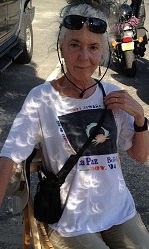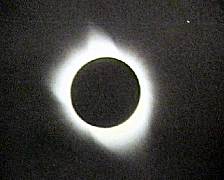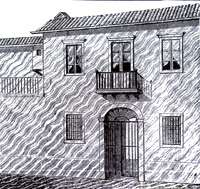
The Eclipse FAQOr, "What the hell is so special about an eclipse, anyway?"It is impossible to describe a total eclipse of the sun. It is an event so awesome, so overwhelming, that people will endure hardship and discomfort just to observe it. We are not astronomers; we just go for the experience, which no photograph or description can convey. We met one astronomer who had once spent hours setting up and calibrating his camera-telescope, and then forgot to take pictures because he was so overwhelmed.
"But I saw an eclipse at [some place and time], and I still don't get it."I hear this a lot. The answer is almost always "no, you didn't." It usually turns out to have been a partial eclipse, or an annular eclipse, or even a lunar eclipse. When we were in South Africa, I met a man who swore he saw the 1991 total eclipse from the top of Haleakela in Maui. But Haleakela was not in the path of totality. On the same trip I met a woman who saw the total eclipse of 1999 in Paris, which, again, was not in the path. People read about a total eclipse, and they see an event, but they usually don't know enough to realize that the event they saw was not totality. Seeing a total eclipse is completely different from seeing a 99% partial eclipse. It's like an orgasm: if you think that you might've had one, then you haven't.Eclipse Effects:The Crescent Effect
Heightened Visual AcuityThis is a very eerie effect. As the eclipse progresses towards totality, more of the sun is covered, so the source of sunlight grows much smaller than usual. This change makes shadows sharper and darker. Shadows that are normally grey and fuzzy become black and razor-edged. Look at your own shadow and see the shadows of the individual hairs on your head! Every object seems more sharply focused. The effect is as if your visual acuity has been cranked up from 10 to 11. It's dark, yet bright. Totally weird.
Wall of DarknessIf you can watch the eclipse from a good vantage point, you can actually see the moon's shadow racing across the world toward you. If there are some clouds or distant mountains, you can still get the effect of an onrushing wall of darkness. Even though you, intelligent biped, know what is happening, the effect produces a jolt of adrenaline. It is a fearsome sight.Shadow Bands
In Bolivia, just as the sun was being blotted out, someone shouted that there were shadow bands. There they were, snaking across the salt flat beneath my feet. I became dizzy from the surreal lighting and the adrenaline.
Meteorological EffectsWhen the sun is covered, the local weather can change rapidly and dramatically. On the Bolivian Altiplano, the temperature dropped from 60 degrees (Fahrenheit) to 40 degrees in a period of about 10 minutes. We had a similar effect in Mongolia. In Baja, clouds formed right around the sun, fortunately not occluding it. Sometimes clouds will clear, other times clouds will form.Totality
bright, sunny day
Diamond Rings and Bailey's BeadsAs the moon covers the sun, in the final seconds a last ray of sunlight is often visible, producing a "diamond ring" effect. The diamond ring is also often visible at the end of totality.Bailey's Beads are like many miniature diamonds, and is caused by the sun's rays shining through several canyons on the moon's surface. The CoronaA surprisingly small halo of pure silver-white light, achingly beautiful. In the darkness stars appear around it. The landscape takes on a strange silvery darkness.Sometimes great prominences extend the silver light; every eclipse looks different. Also, in Turkey we saw three bright red solar prominences that looked like rubies in the silver tiara. The 360-degree SunsetIn the darkness of totality, there is often a sunset along the entire horizon. This was particularly pronounced and beautiful at Baja, Bolivia, and Aruba.Animal ConfusionBirds and other animals decide that it is night and quickly do their dusk activities. Herds of cows head for their barns. Insects go silent.Local ReactionsEvery culture seems to respond differently. Many cultures keep women indoors or even evacuate them from the area of totality. In India, Bolivia, and Mexico, an eclipse is believed to harm a woman's fertility or to cause birth defects. In Mexico, the eclipse was a huge party, with fireworks and music. In Bolivia, a few Indians watched the developing eclipse with us, but at totality they kneeled together and prayed, their eyes averted earthward. At Rajasthan, local villagers were wildly enthusiastic, pointing at flocks of birds and other phenomena, laughing and gesticulating.Our Holiday KarmaThis is not a generic eclipse effect, but a fortuitous happenstance for us. Most of our eclipses have coincided with significant local holidays. In Bolivia, the Day of the Dead happened just before the eclipse, so we participated in this two-day holiday in some of the remotest villages of the Bolivian Altiplano. In India, Divali (the Festival of Lights) is much like our own Christmas and is celebrated with lights, song, and firecrackers. We enjoyed Divali in a small town in a relatively untouristed part of Rajasthan. In the Caribbean, we experienced Carnival in Trinidad, and then flew to Aruba to see the eclipse.Good Links
|
How We Became
So Barbara went to India in the mid-seventies, which led us to
become football fans, which in turn led to our
solar eclipse addiction.
|
 Dharma
Dharma


